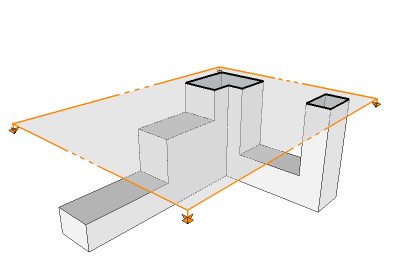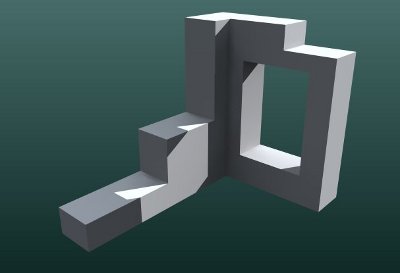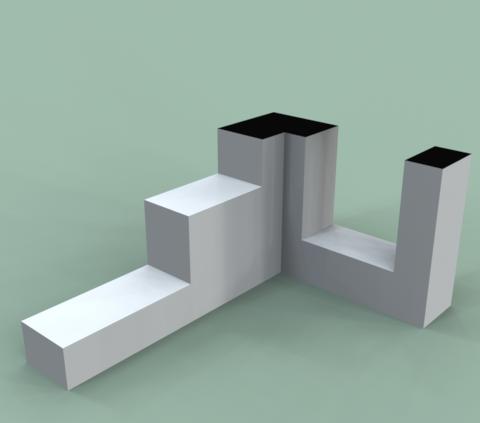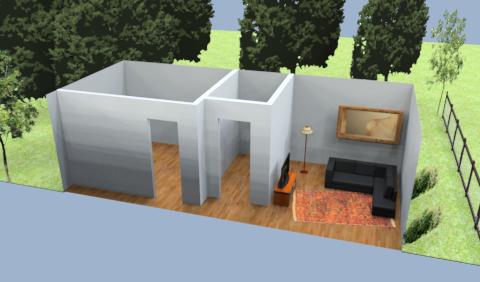How to choose a renderer for SketchUp
-
I think, the proper question should be "Does the render suite that you use, have a guide for rendering a photo match?". For a user, I think it would be better, first to evaluate the need and then find a render that can deliver - someting like here.
-
Based on some user comments, we realized that the tutorial left out sun position, sun intensity, sky color, ground color and edge lines.
We may modify the model and tutorial to add a scene for these, or else just recommend that the user turn the sun on to make sure it works properly.
-
Off topic.
When looking at the video I also stumbled across this:
http://www.youtube.com/watch?v=b2wRE-fdm8s&NR=1&feature=fvwp
-
@pixero said:
Off topic.
When looking at the video I also stumbled across this:
http://www.youtube.com/watch?v=b2wRE-fdm8s&NR=1&feature=fvwp
Speaking of inflatable, we were looking at Television sets last night and saw that they had an inflatable 72" TV. Has anyone purchased an inflatable TV yet?
-
@al hart said:
Based on some user comments, we realized that the tutorial left out sun position, sun intensity, sky color, ground color and edge lines.
We may modify the model and tutorial to add a scene for these, or else just recommend that the user turn the sun on to make sure it works properly.
What about caustics, blurry reflections, dispersion, subsurface scattering, displacement mapping, motion blur, full spectral rendering, proxy objects (we really need a way to overcome the limited support of SU for high poly models), render passes, multi-light... just to keep this interesting.
-
The ability to render section cuts sounds sick! Sadly, I don't know how to activate that option. Here's my simple model...

And here's the resulting render in IDX Renditioner Express Free, Presentation quality:

Here's the SketchUp file in versions 7 and 6 so everyone can give it a try to see what I'm doing wrong:
simple-section-SU6.skp
simple-section-SU7.skpHow did the guy in the video do it, anyway?

Anyway, gotta go now, I'l return in a couple hours to post my findings. -
@ecuadorian said:
How did the guy in the video do it, anyway?
He wasn't using IDX. I don't know how to add section planes to IDX. Perhaps someone else will add a note on how to do it.
Here is your model rendered with IRender nXt (with no changes to the default rendering settings.)

Also, your IDX rendering had the sun on, or some other light source. Did you turn the sun on before you rendered it?
-
@notareal said:
What about caustics, blurry reflections, dispersion, subsurface scattering, displacement mapping, motion blur, full spectral rendering, proxy objects (we really need a way to overcome the limited support of SU for high poly models), render passes, multi-light... just to keep this interesting.
This tutorial was not about render features. Of course, you can compare the features of the various rendering engines to help you in your decision. There are other threads in the gallery forum about which renderers make can make high quality images.
This tutorial was about things which look OK in SketchUp, but may not render in some renderers. The underlying thought was that if you have to modify your model before you can render it (explode items, reverse faces, etc.) or remake settings over again (such as setting the sun position, or defining materials), then that adds work and editing time to the rendering process.
-
Ok,I checked the model from the video, and it has no section planes at all. It's just a tab that hides the upper half of the model, which has been manually sliced, so the section tab in the model can actually be rendered well in all render programs.
-
You are right - the "House Roof Off" scene does not have a section plane - just a hidden roof.
I downloaded the model from the 3D Warehouse and added a section place to that scene on the front wall, and it rendered properly with the roof missing (because it is hidden) and the front wall missing (because of the section plane). (I think I had to move the section plane to the insiide of the wall - but I got confused - because I had a hard time selecting the section plane until I had zoomed out on the model.
Dennis was not trying to fool anyone, but he ran into a problem trying to load the model up to the 3D warehouse because it was too large. He was trying everything - removing scenes (which doesn't really help), removing geometry, but finally he found that the problem was that the images he had downloaded from Google Image Search were just too long. But loading them into Photoshop and making them smaller he was able to get the model under the 10MB limit for the 3D warehouse. (At one point he tried to load a 10.4 MB model - but, sure enough, the Warehouse wouldn't load him upload it. He was under a lot of pressure, because I was running over to his desk every few minutes asking when he would have a model other people could try, and he must have forgotten to put back the section plane.
I'll have him add the section plane to the model on Monday and re-upload it. In the meantime, just add a section plane yourself and see if your renderer can handle it.

-
@al hart said:
@notareal said:
What about caustics, blurry reflections, dispersion, subsurface scattering, displacement mapping, motion blur, full spectral rendering, proxy objects (we really need a way to overcome the limited support of SU for high poly models), render passes, multi-light... just to keep this interesting.
This tutorial was not about render features. Of course, you can compare the features of the various rendering engines to help you in your decision. ...
Ok, so correct if I am wrong... you happen to only test features that IRender do support. So how one can actually choose a render based to this, if only limited set of common features are accepted to test, is that biased? Would it be more honest just to call this IRender feature demo? Othervise, I don't see any difference to a advertorial. Note in some countries advertorials are required to be clearly marked.
-
@notareal said:
@al hart said:
Ok, so correct if I am wrong... you happen to only test features that IRender do support. So how one can actually choose a render based to this, if only limited set of common features are accepted to test, is that biased? Would it be more honest just to call this IRender feature demo? Othervise, I don't see any difference to a advertorial. Note in some countries advertorials are required to be clearly marked.
This particular tutorial was about features in native SketchUp which effect the SketchUp rendering. If SketchUp supports "caustics, blurry reflections, dispersion, subsurface scattering, displacement mapping, motion blur, full spectral rendering, proxy objects, render passes, or multi-light" I am not aware of it. Some renderers support some of these additional features - and even more I suspect - and some renderers may not. I invite other readers of this thread to indicate what features are important. Or I invite anyone to start a new thread on advanced rendering features. I have seen some very good examples of renderings and rendering features in the Gallery forum. I think that it is healthy for SketchUp users to understand the value of Photorealistic rendering add-ons.
-
For my understanding there is no build in renderer in SU, only some OpenGL acceleration, so "features in native SketchUp" is what eryone can see without a renderer - everything else is added feature. Naturally a render pluging should be able to repeat SU functionality, but honestly does one need a renderer just for that?
Certainly some of the advanced global illumination features available from various render plugins, might be overkill for some, but those can be essential to others. For example if interior designer or a architect is using indirect light, should the render plugin produce a acceptable solution. And what if translusent materials are used - blurry reflections and subsurface scattering is fairly native feature of these materials in real world, like caustics for glass, water or metals - all find from SU buildin materials.
Therefore if the video where a real tutorial and not a advertorial, these features should be atleast mentioned, even if this was ment to be focused to basic features (sorry cannot recall if that kind of focus was mentioned in the video). -
If I may....
I just watched the video, read this thread and I have a few questions and observations.
Does Dennis work for Irender?, I think he does as once it was announced here, so for him to set the parameters of what a renderer should have is kinda self serving.
At one point in the video Dennis does a render and says "not a lot has changed, that's the point" really? then why render in the first place?
He uses 2d face-me photo cutouts which when rendered will look like 2d photo cutouts, what's the point of rendering?
Then you have the whole 2d clock, that once rendered looks exactly as it did before rendering...am I missing something here? Is SU not a 3D app? why using all 2d faces? why render at all if you are using photo textures?Then there is the cutout tree that when rendered looks like a 2d tree with soft shadows, that's why top renders have 3d trees as they actually look 3d. I suppose the argument for 2D trees would be because SU cannot handle too many poly's, if this indeed is the case then the whole beginning of the video makes no sense when Dennis says that an integrated render solution is best as that will limit you to use 2D cutouts that look well...2D, where if your render solution was stand alone you could then import your vegetation separately and not be forced to count the polys.
The well/pond thing, who models like that? a face with two material applied on either side, that's elementary modeling mistakes and should not be a renderers problem to solve but rather a users skills not to do.
I do not think this video in anyway should be a guide as IMO it's biased and setup so that only one product can qualify to it's strange requirements of what a render should be like.I believe if the final product in the video is what a user is hoping to achieve then they need not bother rendering as setting up all those 2d images is enough, and if that is the quality you are after then maybe modeling is the first step to achieving a good render.
IMO a good render solution does not have to be integrated, in fact there are pros and cons to this that needs a long discussion, what about biased verses unbiased rendering?
There is no one solution that works for all renders, that's why it's important for a user to look at galleries and see the quality of what can be achieved, then once they have their modeling skills tuned enough to create a render worthy model with good texturing they can download all the free trials and demo apps and find the one they enjoy to use that will give them the results they need. They also need to take int account that today's needs will change as they get better they will require better and better results, so make sure you choice of renderer is not limited to your initial skill set but as you get more advanced so does your ability to use more advanced render setting, and more realistic features, make sure that your render solution does not limit your skills and results because it's limited to being 'easy'. -
@solo said:
If I may....
I just watched the video, read this thread and I have a few questions and observations...
Dennis does work for Render Plus. I asked him to create this tutorial as a starting point for people who are looking for a renderer, who do not know much about rendering, and who are overwhelmed by the thought of trying out all 30 renderers mentioned in the SketchUcation forum.
We are not saying that these are the only qualities you want in a renderer. I guess what we are saying is: If a renderer cannot render the Photo cutouts, or cannot render the 2D clock, or other basic SketchUp features, then perhaps you should consider a different renderer.
-
Al, please do not get me wrong, I'm not on a witch hunt, I just do not agree as to what y'all believe a renderer should be.
@unknownuser said:
We are sent lots of models with 2D faces. Maybe people should not create models like that - but they - especially in massing studies where they create a basic shape for a building and want to wee what it will look like.
If indeed they are using SU for a massing study why in the world would they want to render it? as the photo textures and cutouts would be sufficient IMO.
Why is it necessary for a 'good renderer" to need to be able to render a photo texture?I guess the real question that begs to be asked is What is a render? and why do we render?
Rendering photo textures IMO is silly and not needed, seen any renders on Google earth? as that's pretty much what the model in the video looks like.
-
@solo said:
If I may....
I just watched the video, read this thread and I have a few questions and observations.
Thanks for this assessment of the the video, Pete. As a rendering newbie, I was wondering what to make of the the 'tutorial'. Judging from the quality of your renders in the gallery, you clearly know what you are talking about, and this helps me alot.
I was also wondering who makes models like that clock or well from the video

-
Hi Solo, Very informative post. I did not stop to consider the implication of photographic textures on surfaces, and upon further examination, realized that the 2D trees are such that they do not cast correct shadows in SU.
For me, the value of a renderer is found in its integration into my Cad work flow in order to produce conceptual, as well as final renders. Looking for ease, speed, and beautiful:-)
-
@solo said:
Rendering photo textures IMO is silly and not needed
You would use a similar "distorted texture" technique to place an image of a painting on a painting in the model - if the image of the painting was not head on.
Most images of painting are "head on" - but the ease of "distorting" an image in SketchUp to make an oblique image fill a rectangular area it one of SketchUp's important features.

Also, a Landscape Designer may want to place trees and bushes around an existing house and render it - for example to have a reflective pond - and may want to use a photo image for the existing house.
Une "undercurrent" of this discussion is the difference between really good users of rendering software - who probably already have a preferred renderer and are just glad that a SketchUp renderer is available and beginning renderers who want a lot less. We were working with a local firm last year whose main desire for the renderer we to get reflections of adjacent building into windows of building they were designing. They weren't looking for wonderful renderings - just something better than SketchUp could offer. This is a very simple application which just wants to add reflection to windows - but want the rest of the rendering to look pretty much the same as the SketchUp model they had already created.
-
"By the way, 3,000 people have watched this video on You Tube so far. (I am exaggerating slightly - but it will probably be 3,000 by the time you read this post.)"
Al, this is what concerns me the most. The author of the video has a Renderplus logo that leads straight to your You tube expose page, and then there are postings referring to the renderer used for the video, so in essence it's an advert that is disguised as a decision making tool.
I post here as a user and a moderator, and consider myself pretty unbiased, however I do see this as a marketing ploy in order to get more sales for your product and not an informative and constructive way of educating new users into making a true decision as your video is totally biased and set up for your product.
I also noticed you had a banner ad purchased on this forum to advertise this video too, unless you had something to gain why would you pay to advertise this video?
My point here is if we are going to help folk decide on a render solution then let it be from an unbiased source, let it be fair and most of all let it be accurate.
"If you have other things people should look for in a good rendering engine, go ahead and add them to this thread"
I'd rather say a new thread needs to be started where this video does not get more exposure, where users can contribute as to what they feel is important in a render solution.I hope I'm not coming across to hard or rude, I just think that this video is biased in favour of your product and not accurate to what a renderer should be, I suggest the users decide what's important then a video can be made based on researched needs and not features your product has which others do not.
Advertisement








